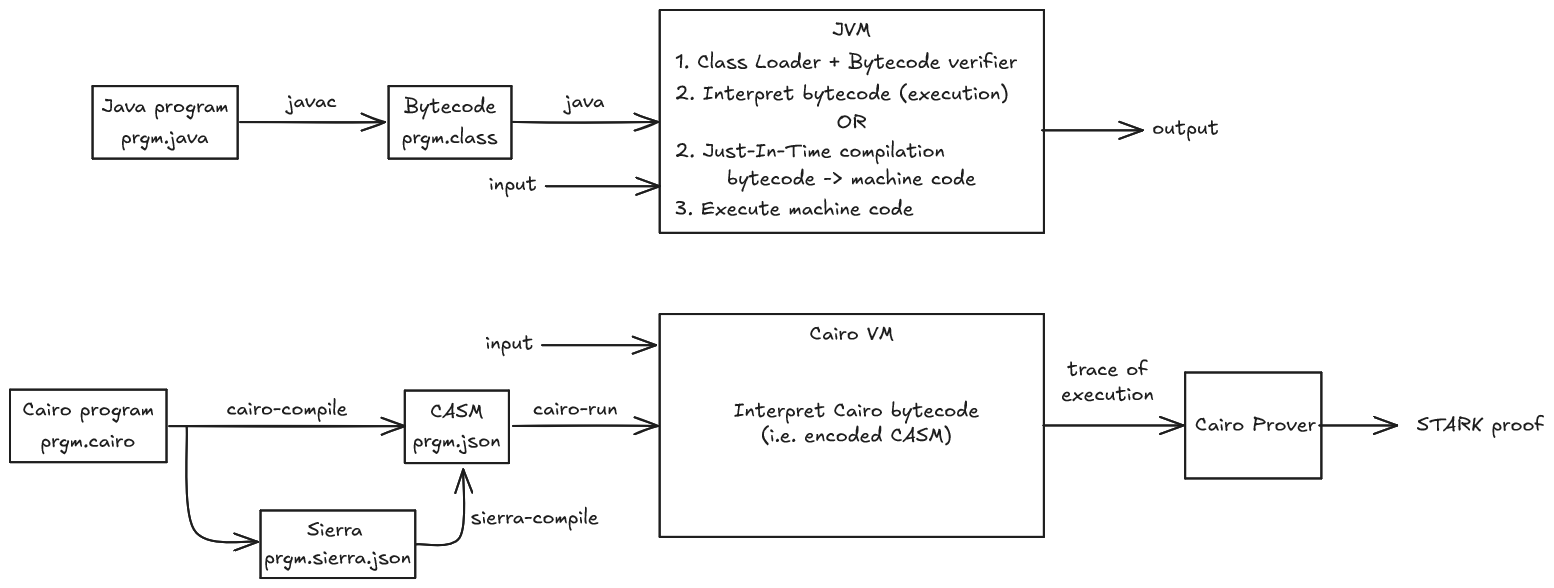Introduction
Ever wondered how your Cairo programs were executed?
First, they are compiled by the Cairo Compiler, then executed by the Cairo Virtual Machine, or Cairo VM for short, which generates a trace of execution, used by the Prover to generate a STARK proof of that execution. This proof can later be verified by a Verifier.
The following chapters will go deep inside the inner workings of the Cairo VM. We'll cover its architecture, its memory model, and its execution model. Next, we'll explore builtins and hints, their purpose, and how they work. Finally, we'll look at the runner, which orchestrates the execution of a Cairo program.
But first, what do we mean by "virtual machine"?
Virtual Machine
Virtual Machines (VMs) are software emulations of physical computers. They provide a complete programming environment through an API which includes everything required for the correct execution of programs above it.
Every virtual machine API includes an instruction set architecture (ISA) in which to express programs. It could be the same instruction set as some physical machine (e.g. RISC-V), or a dedicated one implemented in the VM (e.g. Cairo assembly, CASM).
Those that emulate an OS are called System Virtual Machines, such as Xen and VMWare. We're not interested in them here.
The other ones we're interested in are Process Virtual Machines. They provide the environment needed by a single user-level process.
The most well-known process VM might be the Java Virtual Machine (JVM).
- Given a Java program
prgm.java, it is compiled into a classprgm.class, containing Java bytecode (JVM instructions and metadata). - The JVM verifies that the bytecode is safe to run.
- The bytecode is either interpreted (slow) or compiled to machine code just in time (JIT, fast).
- If using JIT, the bytecode is translated to machine code while executing the program.
- Java programs could also be directly compiled to a specific CPU architecture (read machine code) through a process called ahead-of-time compilation (AOT).
The Cairo VM is also a process VM, similar to the JVM, with one significant difference: Java and its JVM are designed for (platform-independent) general-purpose computing, while Cairo and its Cairo VM are specifically designed for (platform-independent) provable general-purpose computing.
- A Cairo program
prgm.cairois compiled into compilation artifactsprgm.json, containing Cairo bytecode (encoded CASM, the Cairo instruction set, and extra data). - As seen in the introduction, Cairo Zero directly compiles to CASM while Cairo first compiles to Sierra and then to a safe subset of CASM.
- The Cairo VM interprets the provided CASM and generates a trace of the program execution.
- The obtained trace data can be fed to the Cairo Prover in order to generate a STARK proof, allowing to prove the correct execution of the program. Creating this validity proof is the main purpose of Cairo.
Here is a high-level flow diagram showing how a Java program and a Cairo one are executed with their respective compiler and VM. The proof generation of a Cairo program is included.

An ongoing project, Cairo Native works on providing Sierra to machine code compilation, including JIT and AOT, for executing Cairo programs.
Even though the high-level flow of both VMs is similar, their actual architectures are extremely different: the instruction set, the memory model, Cairo's non-determinism and the output.
References
Michael L. Scott, in Programming Language Pragmatics, 2015